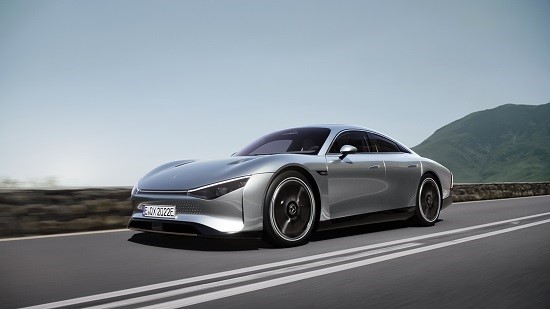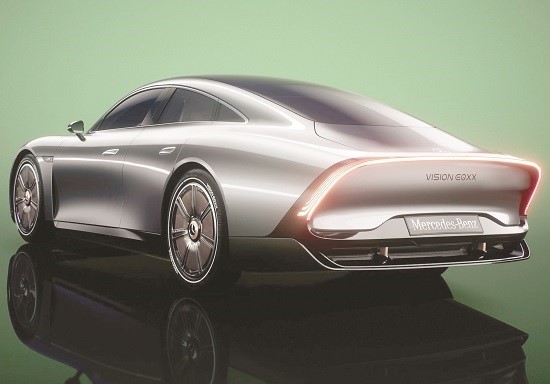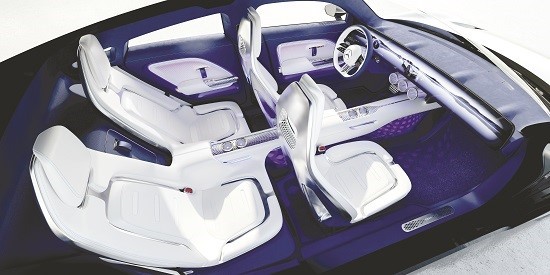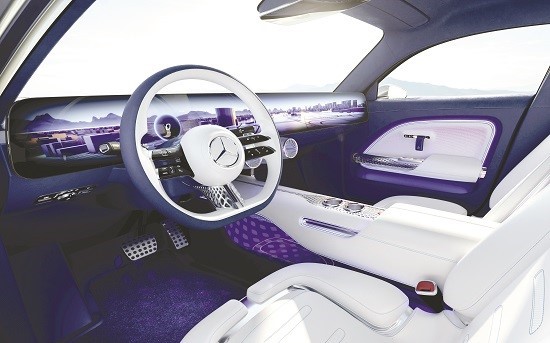Mercedes-Benz presented its electric concept car, VISION
EQXX, during its participation in the
Consumer Electronics Show (CES) in Las
Vegas, a tech show that has become a mecca for carmakers eager to show
electrification capabilities.
اضافة اعلان
The VISION EQXX is an expression of the long-established
German car maker upcoming direction towards the all-electric future of the
Mercedes-Benz electric brand, which currently bears the symbol EQ.
Commenting on this important launch,
Ola Källenius, CEO and
chairman of the Board of Directors of Mercedes-Benz, said: “The
Mercedes-Benz
VISION EQXX is the way we imagine the future of electric cars. Only a year and
half ago, we started this project that led to the production of the most
efficient Mercedes-Benz cars ever made, with an impressive energy consumption
of less than 10 kilowatt-hour per 100m. It has a range of more than 1,000km on
a single charge using a battery that fits even a small vehicle. The VISION EQXX
is an advanced car in many dimensions — it looks stunning and futuristic. It indicates where our entire company is
heading as we look to offer the world’s most desirable electric vehicles.”
 (Photo: Daimler Media)
(Photo: Daimler Media)
Mercedes says that issues of range and efficiency are the
factors that will determine future competitive success in the automotive world,
which is in essence the world of electric cars.
The issue of the long-range is the most influential element
in accelerating the process of consumers’ adaptation and their recognition of
the electric option. As for efficiency,
it is related to that golden equation between the size and weight of the cars’
electric battery system, which means greater capacity and longer range.
Through this innovative project of the VISION EQXX, it
appears that Mercedes-Benz intends to challenge the industry’s norms in the
areas of range and efficiency. It is
good to know that Mercedes’s EQS 450+ has an already amazing actual Range of
675km per single charge, making the German electric vehicle maker the proud
holder of the title of the highest Range of electric cars sold on the market so
far.
 (Photo: Daimler Media)
(Photo: Daimler Media)
Mercedes-Benz says that this new concept of cars is the
result of a joint effort of a group of best minds and expertise from
Mercedes-Benz and other companies, among whom are the high-performance
powertrain engineers working in the Formula 1 racing program at Mercedes-AMG
High-Performance Powertrains (HPP). They
are credited for having a tremendous experience in the field of
microengineering and extreme performance; the optimal use of size and weight to
extract the highest possible power; as well as the use of artificial
intelligence and 3D printing to solve engineering problems.
All these efforts come together to achieve remarkable
progress that defies the current obstacles of range and efficiency. Within only
a year and a half, the team was able to achieve a tangible colossal
achievement, represented by a figure of 10 kilowatt-hour per 100km, which
means that the 100 Kilowatt-hour battery is able to provide the energy needed
to travel a distance of 1,000km on a single charge. This highly effective battery is
characterized by a smaller size and significantly smaller weight; innovative
and improved efficiency of the power system (the electric motor, transmission
and all related parts), as well as the energy density in the battery, in
addition to challenging the possible in aerodynamics and the light weight of
the body and chassis.
 (Photo: Daimler Media)
(Photo: Daimler Media)
One of the most prominent engineering achievements of this
project is the development of Mercedes-Benz modular architecture, which is the
platform for building the upcoming Mercedes electric cars, especially in the
compact and medium car segments, as well as the development of the UX/UI user
experience communication system between the car and passengers, which was
developed in an amazing way that mimics the intuition of the human mind. In
addition, great expertise was used in the production of environmentally
friendly alternative organic materials to create an animal-free passenger
cabin, for example. Another innovation
is the solar cell system that generates enough energy to power many of the
electrical component’s equipment in the VISION EQXX. This solar system consists
of 117 solar cells on the roof, which reduces battery energy drain, adding up
to 25km of range on long trips in ideal conditions.
From a design perspective, the engineering goal was to
maximize efficiency and range, and since the car’s ability to penetrate the air
as it moves is a key element in deciding the extent of its energy consumption,
aerodynamics had a significant impact on range.
Mercedes-Benz says that in normal long-distance driving, an electric car
consumes roughly two-thirds of its battery capacity to make its way through the
air, which is why the team of engineers at Mercedes-Benz focused on this point,
achieving the nearly impossible; the VISON EQXX has a drag ratio of just 0.17,
which is an air resistance measure. To
know how miraculous this number is, let us compare it with its sister EQS,
which boasts a drag ratio of 0.20, which is considered the best in the world
among cars in production.
 (Photo: Daimler Media)
(Photo: Daimler Media)
Gorden Wagener, chief design officer Daimler AG and
Mercedes-Benz AG, explains: “The VISION EQXX is a vision of the future that
embodies the desire for the next level of luxury from Mercedes. As designers,
we always think in terms of technology and aesthetics. The aerodynamics of the
VISION EQXX embody this fusion of tech and aesthetic for us as designers. In
line with our philosophy of Sensual Purity, we created spectacular proportions
that combine beauty with efficiency. The resulting body flow delivers
revolutionary aerodynamics. The fact that the end result is as beautiful as it
is bears testament to the skill of our design team working in close
collaboration with the aerodynamics experts.”
The devil is in the details of the VISION EQXX, and the
numbers are the highlight of the genius of this concept. We start with the
horsepower output which is ‘only’ 150 kilowatts of power, or what translates
into 204 horsepower. We say ‘only’ because in the world of electric cars we are
used to astronomical numbers of power.
The Mercedes EQS boasts 525 horsepower, but the secret to the power
number is the very lightweight of the VISION EQXX; merely 1750kg, which is
rare among electric cars that suffer from “obese” weights such as 2510kg for
the Mercedes EQS mentioned earlier.
The VISION EQXX represents the biggest game-changer that
Mercedes-Benz is offering today in the electric challenge and the electric
competition arena, signaling its intention to lead again as it once did, and
aspiring to remain “the best or nothing” car brand.
Read more Drive



